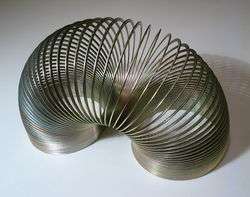Richard T. James

Richard Thompson James[1] (January 1, 1914 in Delaware, USA – 1974 in Bolivia)[2] was a naval engineer, best known for inventing the Slinky spring toy with his wife Betty James in Clifton Heights, Pennsylvania in 1943.
Education
He was born on January 1, 1914. 1935 James graduated from Westtown School, a Quaker boarding school located in Chester County, Pennsylvania. In 1939 he graduated in with a degree in Mechanical Engineering from The Pennsylvania State University.[3]
Career
In 1943 James was trying to develop a means for suspending sensitive shipboard instruments aboard naval vessels, even in rough seas, and was working with tension springs when he accidentally dropped one. Seeing how the spring kept moving after it hit the ground, and an idea for a toy was born.
With a $500 loan, James developed a coil winding machine and started the James Spring & Wire Company to mass-produce the Slinky. The following year, Betty came up with the name Slinky after leafing through the dictionary and thinking that the word described the motion of the spring. The couple made 400 of the toys and convinced the Gimbels department store in Philadelphia to carry the toy for Christmas 1945 displayed on a ramp. These first models were all sold within 90 minutes at a price of $1 each.[4] The toy became a huge success, with around 300 million Slinkys purchased since then. A quarter of a billion Slinkys are still sold every year around the world today.
Around 1960, Richard went to Bolivia to join Wycliffe Bible Translators,[5] and Betty James took over as CEO of James Industries.[6] She moved the company from Philadelphia to its current Hollidaysburg, Pennsylvania location and began an active advertising campaign, complete with the famous Slinky jingle. She was inducted into the Toy Industry Hall of Fame in 2001.
James died in 1974 in Bolivia. Betty died on November 20, 2008, age 90 at the Hospital of the University of Pennsylvania in Philadelphia. Death was unexplained.
References
- ↑ MIT: Richard James
- ↑ priceonomics.com
- ↑ Penn State: What’s the connection between a Slinky and Penn State?
- ↑ Hevesi, Dennis. "Betty James, Who Named the Slinky Toy, Is Dead at 90", The New York Times, November 24, 2008. Accessed November 25, 2008.
- ↑ "'Slinky' brainchild". Delaware County Daily Times. Retrieved 2014-01-25.
- ↑ CNN.com
External links
- Slinky patent
- Delaware County Times article, 26 August, 1948
- Delaware County Daily Times article, 25 November 1976